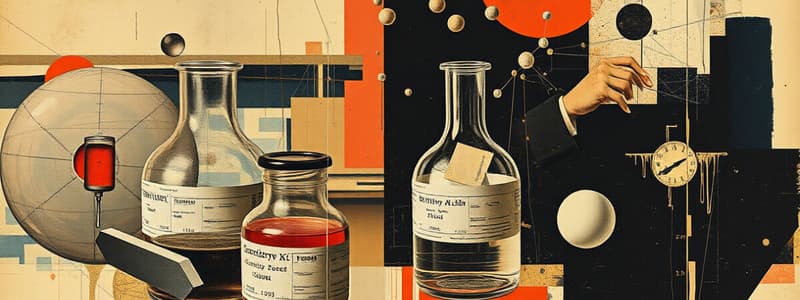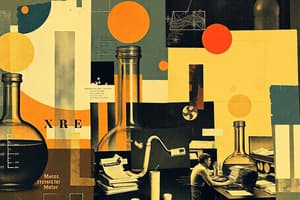Podcast
Questions and Answers
What does the Law of Definite Proportions state about compounds?
What does the Law of Definite Proportions state about compounds?
- Compounds are made of different elements.
- Compounds can change their proportions based on environmental factors.
- A compound is always composed of the same elements in the same proportion by mass. (correct)
- Compounds can vary in composition.
Which statement correctly describes acids?
Which statement correctly describes acids?
- Acids donate protons (H+) in solution. (correct)
- Acids accept protons in solution.
- Acids are always solids.
- Acids usually have a bitter taste.
What is the primary function of catalysts in chemical reactions?
What is the primary function of catalysts in chemical reactions?
- They change the equilibrium of reactions.
- They increase the temperature of reactions.
- They undergo permanent changes.
- They speed up reactions without undergoing permanent changes. (correct)
What term describes the study of heat changes during chemical reactions?
What term describes the study of heat changes during chemical reactions?
Which of the following options correctly describes an endothermic reaction?
Which of the following options correctly describes an endothermic reaction?
Which branch of chemistry focuses on carbon-containing compounds?
Which branch of chemistry focuses on carbon-containing compounds?
What is the smallest unit of an element?
What is the smallest unit of an element?
What type of bond is formed by the transfer of electrons between atoms?
What type of bond is formed by the transfer of electrons between atoms?
Which of the following is NOT a physical property of matter?
Which of the following is NOT a physical property of matter?
Which state of matter has a definite shape and volume?
Which state of matter has a definite shape and volume?
What does the law of conservation of mass state?
What does the law of conservation of mass state?
Which type of chemical reaction involves the breakdown of a compound into simpler substances?
Which type of chemical reaction involves the breakdown of a compound into simpler substances?
In the periodic table, what do periods represent?
In the periodic table, what do periods represent?
Flashcards are hidden until you start studying
Study Notes
Basics of Chemistry
- Chemistry is the study of matter, its properties, composition, structure, and the changes it undergoes.
- Divided into several branches:
- Organic Chemistry: Study of carbon-containing compounds.
- Inorganic Chemistry: Study of inorganic compounds, such as metals and minerals.
- Physical Chemistry: Study of the physical properties and behavior of chemical systems.
- Analytical Chemistry: Techniques and methods to analyze substances.
Matter and Its Properties
- Matter is anything that has mass and occupies space.
- Properties of matter can be classified as:
- Physical Properties: Characteristics that can be observed without changing the substance (e.g., color, melting point).
- Chemical Properties: Characteristics that become evident during a chemical reaction (e.g., reactivity, flammability).
Atoms and Molecules
- Atoms: The smallest unit of an element, composed of protons, neutrons, and electrons.
- Molecules: Two or more atoms bonded together, can be the same (e.g., O2) or different (e.g., H2O).
The Periodic Table
- Organizes elements based on atomic number, electron configuration, and recurring chemical properties.
- Groups (columns) indicate elements with similar properties.
- Periods (rows) show the number of electron shells.
Chemical Bonds
- Ionic Bonds: Formed by the transfer of electrons from one atom to another, resulting in positively and negatively charged ions.
- Covalent Bonds: Formed by the sharing of electrons between atoms.
- Metallic Bonds: Involves the pooling of free electrons among a lattice of metal atoms.
Chemical Reactions
- A process in which substances (reactants) are transformed into new substances (products).
- Types of reactions include:
- Synthesis: Combination of two or more substances to form one compound.
- Decomposition: Breakdown of a compound into simpler substances.
- Single Replacement: One element replaces another in a compound.
- Double Replacement: Exchange of ions between two compounds.
States of Matter
- Matter exists in four primary states:
- Solid: Definite shape and volume.
- Liquid: Definite volume but takes the shape of its container.
- Gas: No definite shape or volume, expands to fill the container.
- Plasma: Ionized gas with free-moving ions and electrons.
Laws of Chemistry
- Law of Conservation of Mass: Mass is neither created nor destroyed in a chemical reaction.
- Law of Definite Proportions: A compound is always composed of the same elements in the same proportion by mass.
Acids and Bases
- Acids: Substances that donate protons (H+) in solution, usually have a sour taste (e.g., hydrochloric acid).
- Bases: Substances that accept protons or donate hydroxide ions (OH-), usually have a bitter taste (e.g., sodium hydroxide).
- pH scale measures the acidity or basicity of a solution (0-14 scale).
Stoichiometry
- The calculation of reactants and products in chemical reactions.
- Uses balanced chemical equations to determine the ratios of moles, mass, or volume.
Thermochemistry
- Study of heat changes during chemical reactions.
- Endothermic reactions absorb heat, while exothermic reactions release heat.
Important Concepts
- Catalysts: Substances that speed up chemical reactions without undergoing permanent changes.
- Equilibrium: A state in which the rates of the forward and reverse reactions are equal, and the concentrations of reactants and products remain constant.
Basics of Chemistry
- Chemistry explores matter’s properties, composition, structure, and transformation.
- Major branches include:
- Organic Chemistry: Focuses on carbon-based compounds.
- Inorganic Chemistry: Examines non-carbon compounds like metals and minerals.
- Physical Chemistry: Investigates physical properties and behaviors of chemical systems.
- Analytical Chemistry: Involves techniques for substance analysis.
Matter and Its Properties
- Matter is defined by mass and the space it occupies.
- Properties of matter are categorized into:
- Physical Properties: Observable traits without chemical alteration (e.g., color, melting point).
- Chemical Properties: Characteristics revealed during chemical reactions (e.g., reactivity, flammability).
Atoms and Molecules
- Atoms: The fundamental units of elements, consisting of protons, neutrons, and electrons.
- Molecules: Structures formed by two or more bonded atoms; can be homonuclear (e.g., O2) or heteronuclear (e.g., H2O).
The Periodic Table
- Elements organized by atomic number and recurring chemical properties.
- Groups (columns) correspond to similar properties among elements.
- Periods (rows) reveal the number of electron shells in elements.
Chemical Bonds
- Ionic Bonds: Created by electron transfer, resulting in charged ions.
- Covalent Bonds: Result from electrons being shared between atoms.
- Metallic Bonds: Involve a collective pooling of electrons among metal atom lattices.
Chemical Reactions
- Reaction processes convert reactants into products.
- Key types of reactions include:
- Synthesis: Formation of a compound from multiple substances.
- Decomposition: Breakdown of a compound into simpler substances.
- Single Replacement: Replacement of one element in a compound by another.
- Double Replacement: Ion exchange between two compounds.
States of Matter
- Matter exhibits four fundamental states:
- Solid: Maintains a definitive shape and volume.
- Liquid: Has a definite volume but conforms to the shape of its container.
- Gas: Lacks definite shape and volume, expanding to fill its container.
- Plasma: Ionized gas featuring free-moving ions and electrons.
Laws of Chemistry
- Law of Conservation of Mass: Mass remains constant in chemical reactions; it cannot be created or destroyed.
- Law of Definite Proportions: Compounds have consistent element ratios by mass.
Acids and Bases
- Acids: Proton donors in solutions, often sour-tasting (e.g., hydrochloric acid).
- Bases: Proton acceptors or hydroxide ion donors, generally bitter (e.g., sodium hydroxide).
- pH scale (0-14) measures solution acidity or basicity.
Stoichiometry
- Involves calculations of reactants and products in reactions.
- Relies on balanced chemical equations for mole, mass, or volume ratios.
Thermochemistry
- Studies heat changes associated with chemical reactions.
- Endothermic Reactions: Absorb heat from surroundings.
- Exothermic Reactions: Release heat to surroundings.
Important Concepts
- Catalysts: Substances that enhance reaction rates without permanent changes.
- Equilibrium: A condition where forward and reverse reaction rates equalize, stabilizing reactants and products' concentrations.
Studying That Suits You
Use AI to generate personalized quizzes and flashcards to suit your learning preferences.




